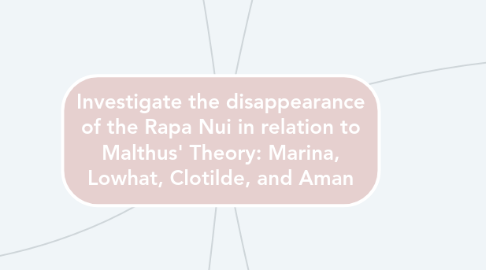
1. Relation to Malthus Theory
1.1. Malthus’ Theory states that the population of the Earth will grow too quickly and we will run out of resources (mostly food).
1.2. What happened to the Rapa Nui is proof that Malthus’ theory is true on a small scale. They did run out of food, and had too big of a population for the island.
1.3. However, this was a special case as Easter Island was specifically isolated from land, and there were other factors leading to their disappearance.
1.4. They used resources unsustainably, which is something Malthus believed will be a main cause to a global crisis when we run out of food.
2. The Rapa Nui
2.1. It is believed that the Rapa Nui settled in the island around 400 AD.
2.2. Europe discovered the island thanks to a Dutch navigator in 1722.
2.3. The Rapa Nui speak Spanish and the Rapa Nui language.
2.4. They are known for their carvings or statues
2.5. There were two types of class or races “Long-eared or short-eared”.
2.6. Resources they used
2.6.1. They utilised all wood from trees available, some of it wasted on unnecessary products.
2.6.2. Fertile land eroded away, leaving poor conditions for farming.
2.6.3. They made fishing boats to catch fish for food - but allegedly lost interest after a while.
2.6.4. When they became desperate for food they began to eat rats and birds that they could find.
3. Reasons they disappeared
3.1. They depleted all the resources they had and the island's population grew too big.
3.2. Easter Island has no permanent source of freshwater.
3.3. Other Theories
3.3.1. They were constantly in a state of war with other tribes, killing each other off. (However their weapons have been proved not suitable for fights)
3.3.2. The arrival of Europeans and the beginning of the slave trade brought disease to the island.
3.3.3. Disease carried by animals which they could have eaten. (E.g. rats)
4. Location and Physical features
4.1. It is surrounded by ocean with no freshwater lakes or rivers.
4.2. Like many islands, Easter Island was formed by three large volcanoes, so it is very mountainous.
4.3. Easter Island is located 3,510 km west of Chile.
4.4. It is considered the most remote inhabited island in the world.
4.5. It is believed that before it was colonised, the island had many forests.
5. Future predictions
5.1. Sufficient production around the world but distribution makes it so that not everyone has what they need.
5.2. Global scale due to a strain on earth resources. We use around 1.7 earths of resources.
5.3. Likely for something similar to happen again in developing countries.
5.3.1. Not enough resources for the amount of people living in the country.
5.3.2. Less likely to have access to enough trade to get resources that aren't available in their country.
5.3.3. In developing countries, the birth rate tends to be higher - meaning a bigger chance for overpopulation in that country.

